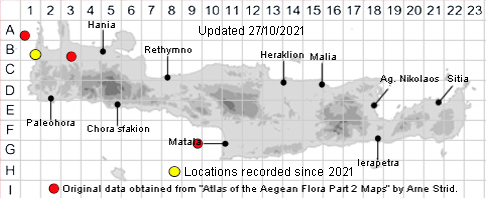
DIANTHUS FRUTICOSUS subsp. OCCIDENTALIS
Family and Genus:- See- CARYOPHYLLACEAE/Subgenus ARMERIASTRUM
Common Names:- Wild carnation.
Homotypic Synonyms:- None
Meaning:- Dianthus (Gr) Zeus'-flower. A name used by the Greek philosopher
Theophrastus.
Fruticosus (L) Of shrub-like habit.
Occidentalis (L) Western, of the west.
General description:- Small shrub, with tortuous branches.
Stems:-
1) Up to 30 cm.
Leaves:-
1) Elliptical or obovate, slender, tapering cylinder, more or less terete, fleshy, tips
rounded, glaucous.
Flowers:-
1) Numerous, scentless.
2) Pedicels, short.
3) Epicalyx-scales, (8-)10-20, obovate, cuspidate.
4) Calyx, 20-26 mm x 2-3 mm, narrowed from about the middle.
5) Petal-limb, c.11-14 mm, dentate, bearded, pink to pale pink.
Fruit:-
1) Capsule, dehiscing apically with 4 teeth; carpophore often present.
2) Seeds, numerous, concave on 1 side.
Key features:-
1) Calyx, not more than 3 mm wide, narrowed from about the middle.
2) Flowers, not in bracteate heads.
Habitat:- Rocks of submontane and lowland zones to 400 m.
Distribution:- Endemic to W. & S. Crete, Ionian islands, S.Peloponnisos,
Idra & Kithira.
Flowering time:- June-July.
Photos by:- Fotis Samaritakis
Status:-
Conservation status (for threatened species): Vulnerable (V) according to IUCN
1997
Protection status (for threatened species): Greek Presidential Decree 67/1981
SPECIES DESCRIPTION
